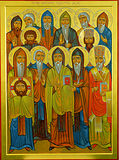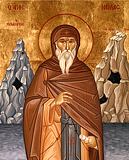

| Previous day | Next day |
| Old Style
May 7
|
Monday |
New Style
May 20
|
| 4th Week after Pascha. Tone 3. | No fast.
|
![]() Commemoration of the Apparition of the Sign of the Precious Cross over Jerusalem in a.d. 351 (351).
Commemoration of the Apparition of the Sign of the Precious Cross over Jerusalem in a.d. 351 (351). ![]() Martyr Acacius the Centurion, at Byzantium (303).
Martyr Acacius the Centurion, at Byzantium (303).
St. John of Zedazeni in Georgia, and 12 disciples: Sts. Shio of Mgvime, David of Gareji, Anthony of Martqopi, Thaddeus of Urbnisi (or Stepantsminda), Stephen of Khirsa, Isidore of Samtavisi, Michael of Ulumbo, Pyrrhus of Breta, Zeno of Iqalto, Jesse (Ise) of Tsilkani, Joseph of Alaverdi, and Abibus of Nekressi (6th c.). Repose of St. Nilus, founder of Sora Skete (Belozersk) (1508). Uncovering of the relics of St. Nilus the Myrrh-gusher, of Mt. Athos (1815). Synaxis of the Saints of St. Panteleimon Monastery (Mt. Athos).
'Lyubech' (11th c.) and 'Zhirovits' (1470) Icons of the Most Holy Theotokos.
St. Lydia of Philippi (1st c.). Uncovering of the relics of St. Euthymius the Great (473). St. Domitianus, bishop of Maastricht (560). St. John of Beverley, bishop of York (721). King Bagrat III of Georgia (1014). New Martyr Pachomius the Russian, of Usaki near Philadelphia (1730). St. John the Confessor, of Psycha on the Bosphorus (ca. 825).
Repose of Monk Nicholas (Boris in schema) of Valaam and Pskov (1969).
Thoughts for Each Day of the Year
According to the Daily Church Readings from the Word of God
By St. Theophan the Recluse

Monday. [Acts 10:1–16; John 6:56–69]
When the Lord presented His teaching about the mystery of His Body and Blood, setting it as a necessary condition for communication with Himself and as a source of true life, then many of His disciples went back, and walked no more with Him (John 6:66). Such an act of God’s boundless mercy toward us seemed too miraculous to them, and their disinclination toward the miraculous tore them from the Lord. The Lord saw this, and although He was prepared to be crucified for the salvation of every person, He did not consider it possible to diminish or cancel the miraculous. It is so crucial in the economy of our salvation! Albeit with regret, He allowed them to depart from Him into the darkness of unbelief and destruction; and said to them and to the chosen twelve as well, will ye also go away? (John 6:67) This showed that He was ready to let them go also, if they could not bow down before the miraculous. So it is, that to flee from the miraculous is to flee from the Lord and Saviour; and one who turns away from the miraculous is as one who is perishing. May those who are horrified by the miraculous heed this! Even they will come across a miracle which they will not be able to thwart: death, and after death, judgment. But whether this inability to thwart it will serve them unto salvation, only God knows.
Articles
 Martyr Acacius the Centurion at ByzantiumSaint Acacius lived in the third century, and was an officer in the Roman army during the time of Maximian. |
 St. Jesse, Bishop of Tsilkani in GeorgiaSaint Jesse of Tsilkani arrived in Georgia in the 6th century with the other Syrian fathers and companions of Saint John of Zedazeni. |
 Icon of the Mother of God of LubechThe Lubech Icon of the Mother of God received its name from the city of Lubech, on the outskirts of Chernigov. |
 Icon of the Mother of God of ZhirovitsThe Zhirovits Icon of the Mother of God appeared in the year 1470 in the vicinity of Zhirovits on the Grodnensk frontier. |












